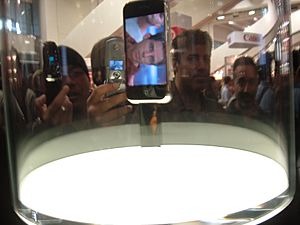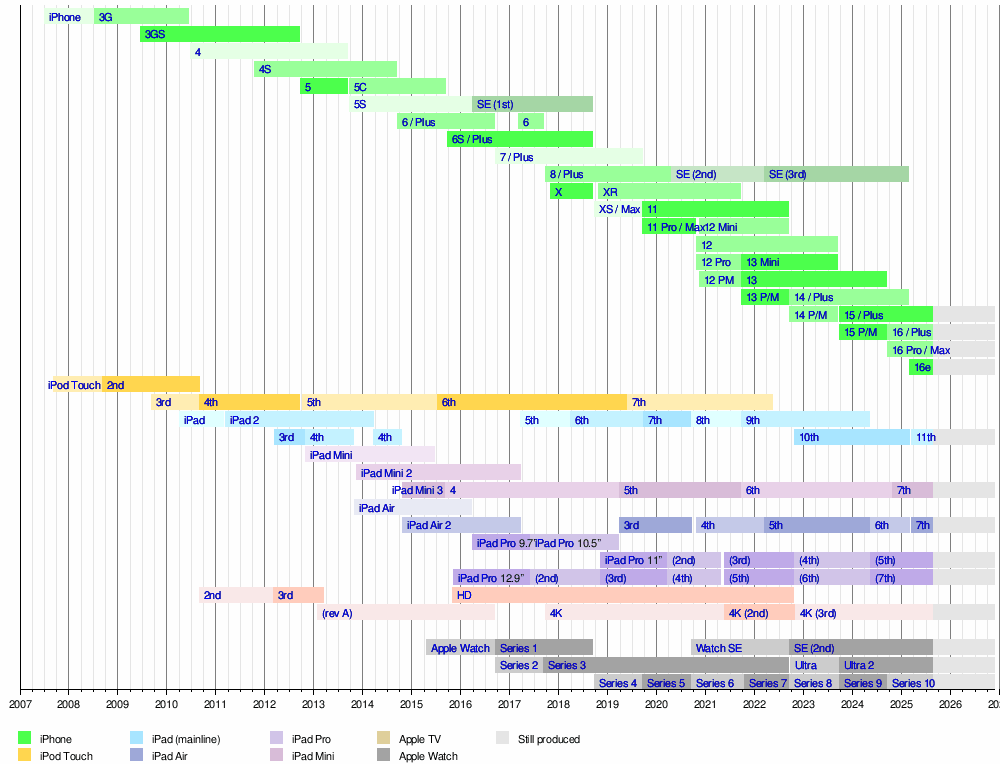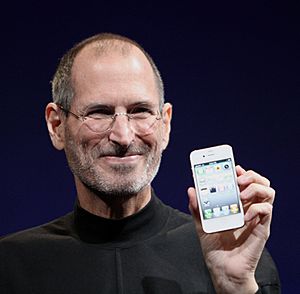History of the iPhone facts for kids

The iPhone is a super popular smartphone made by Apple Inc.. Its story began in the early 2000s. The very first iPhone came out in 2007. By the end of 2009, iPhone models were available in most big markets around the world.
Contents
How the iPhone Idea Started
The idea for an Apple phone came from Jean-Marie Hullot. He was a software engineer from NextStep, which later became part of MacOS. At first, Steve Jobs, Apple's CEO, wasn't keen on making a phone. But Hullot managed to convince him.
A first team started in Paris. However, Jobs didn't take the project seriously until a few years later. The French engineers were asked to move to the US. Hullot said no and left Apple with his team. Another engineer, Henri Lamiraux, then led the project with Scott Forstall to create the iPhone's software.
Early Steps in Making the iPhone
The iPhone project at Apple Inc. really kicked off in 2004. CEO Steve Jobs asked his top engineers, Tony Fadell (hardware), Scott Forstall (software), and Sir Jonathan Ive (design), to work on a secret project called "Project Purple."
Jobs wanted to explore touchscreens and tablet computers. This led to the iPad later on. He pushed for a touch-screen device that looked a lot like Apple's older touch-screen device, the Newton MessagePad. Like the Newton, the iPhone is mostly screen. Its cool shape and look are thanks to Apple's Chief Design Officer, Jonathan Ive.
Steve Jobs didn't think tablet PCs or PDAs were big markets for Apple. But he saw that mobile phones and music players were becoming more alike. In 2002, after the iPod came out, he realized Apple needed to get into the phone business. He saw millions of people carrying separate BlackBerrys, phones, and iPod MP3 players. He felt people would eventually want just one device.
Jobs also knew that as phones got more features, they would challenge the iPod. To protect the iPod, which made up almost half of Apple's money by 2007, Jobs decided to enter the wireless world. So, instead of a new Newton PDA, Apple focused on the iPod. Apple also developed the iTunes software, released in 2001. iTunes helps you put music and other content on your iPod.
Many new technologies made the iPhone possible. These included small, powerful lithium-ion batteries. They could power a mobile computer for a good amount of time. Also, multi-touch screens, energy-efficient but strong CPUs (like those using the ARM architecture), mobile phone networks, and web browsers were key.
In 2005, Apple asked Corning, a glass maker, for a thin, strong, clear material. This was to stop metal keys from scratching phone screens. Corning used old research to create Gorilla Glass.
From Testing to Launch
An iPhone test version was made in 2004. This helped Apple test the device and its features. This beta version was never sold to the public. So, it's not considered the first iPhone.
Steve Jobs first tried to work with Motorola. On September 7, 2005, Apple and Motorola teamed up to create the Motorola ROKR E1. This was the first phone to use iTunes. But Steve Jobs wasn't happy with the ROKR. It could only store 100 iTunes songs to avoid competing with Apple's iPod nano. Also, you couldn't download music wirelessly. You had to sync it through a computer. So, Apple decided to make its own phone. It would combine the iPod's music features with a smartphone.
Apple felt that working with Motorola stopped them from designing the phone they truly wanted. So, Apple stopped supporting the ROKR in September 2006. After making a deal with AT&T (then called Cingular), Apple released a new version of iTunes. It hinted at a new phone that could show pictures and videos. This turned out to be the first iPhone (iPhone 2G).
On January 9, 2007, Steve Jobs announced the first iPhone at the Macworld event. It got a lot of media attention. On June 11, 2007, Apple announced at the Apple's Worldwide Developers Conference that the iPhone would support apps made by other companies. These apps would use the Safari web browser. People could use them through the Internet. The first of these apps, called OneTrip, helped users keep track of their shopping lists.
The first iPhone was released on June 29, 2007. The iPod Touch, which had an iPhone-style touchscreen, came out later in 2007. The iPad followed in 2010.
iPhone's Release in the United States
When Apple announced the iPhone in 2007, it was only sold with AT&T (formerly Cingular) phone plans in the United States. After 18 months of talks, Steve Jobs made a deal with AT&T to be the only carrier for the iPhone. This meant customers couldn't use other phone companies without unlocking their device.
Apple kept control over the iPhone's design, making, and advertising. Some customers tried to jailbreak their iPhones to use other networks. AT&T then charged them a $175 fee for leaving their contract early.
Big Phone Bills
About a month after the iPhone came out, stories about huge phone bills started appearing online. A woman named iJustine received a 300-page iPhone bill in a box in August 2007. She made a viral video about it, which quickly became famous online. This video made the news and showed everyone how big these bills could be. Ten days later, after the video was seen over 3 million times, AT&T sent iPhone users a text message. It explained changes to their billing system.
Price Drop Concerns
On September 5, 2007, the 4 GB iPhone model was stopped. The 8 GB model's price was cut by a third, from $599 to $399. If you bought an iPhone in the 14 days before this price drop, you could get a $200 refund from Apple or AT&T.
But many people who bought their iPhones earlier, between June 29 and August 22, were upset. They felt this was a very big price drop for such a short time. They accused Apple of unfair pricing.
To respond to these complaints, Apple CEO Steve Jobs wrote an open letter on September 6, 2007. He said that everyone who bought an iPhone at the higher price and didn't get a refund would receive a $100 credit. This credit could be used to buy anything in Apple's stores or online.
iPhone 3G Pricing Changes
When the iPhone 3G came out on July 11, 2008, Apple and AT&T changed how it was priced in the US. AT&T would pay a large part of the iPhone 3G's upfront cost. In return, customers would pay slightly higher monthly fees for at least a two-year contract. This was a common way to sell phones in the United States.
iPhone 4 CDMA Release
There were rumors that Apple might offer an iPhone that worked with CDMA networks for Verizon Wireless. These rumors grew stronger in October 2010. The Wall Street Journal reported that Apple would start making a CDMA iPhone. It was expected to go on sale in early 2011.
On January 11, 2011, Verizon announced a deal with Apple. They would start selling a CDMA iPhone 4. The Verizon iPhone went on sale on February 10, 2011. This CDMA version was special. It didn't have a SIM card slot and had a different metal body. This design was later used for the iPhone 4S.
During the launch of the iPhone 4S on October 4, 2011, Apple announced that Sprint would also sell the CDMA iPhone 4 and iPhone 4S in the US starting October 14. Later, Cricket Wireless and Virgin Mobile USA became the first prepaid carriers in the US to offer the iPhone 4 and 4S in June 2012. T-Mobile USA started offering the iPhone on April 12, 2013.
iPhone Around the World
The iPhone was released in different countries over several months. Today, you can buy an iPhone in most countries around the world.
| Date | Country | Carrier(s) (released date) |
|---|---|---|
| June 2007 | AT&T (2007), Verizon (February 2011), Sprint (October 2011), C Spire Wireless (Late 2011), Cricket (June 2012), Virgin Mobile (June 2012), T-Mobile (April 2013), Boost Mobile (November 2013), U.S. Cellular (November 2013) | |
| November 2007 |
O2, 3, T-Mobile, Orange, Vodafone, EE, Tesco Mobile§, Virgin Mobile (November 2013) | |
| March 2008 |
T-Mobile, O2, Orange | |
| July 2008 |
3, movistar, Optus, Orange (Mobistar, One, Optimus), Rogers Communications (Fido Solutions, Rogers Wireless), SoftBank, Swisscom, América Móvil (Telcel), TIM, TeliaSonera (NetCom), Telstra, T-Mobile, Vodafone | |
| August 2008 |
3, América Móvil (Claro, Comcel, Porta), Era, movistar, O2, Orange, Singtel, Bharti Airtel, Aircel, Globe, Smart – December 2011, Swisscom, TeliaSonera (EMT), T-Mobile, Vodafone, Telenor | |
| September 2008 |
TIM, América Móvil (Claro), TeliaSonera (LMT, Omnitel), Turkcell, Vivo, Vodafone (Vodacom), MTN Group, Oi | |
| October 2008 |
Beeline, MegaFon, MTS | |
| November 2008 |
T-Mobile, Vodafone, Mobinil | |
| Later 2008 |
América Móvil (Claro, MiPhone), Chunghwa Telecom, movistar, Orange, Vodafone | |
| January 2009 |
True Move | |
| February 2009 |
Mobily, Etisalat, du | |
| March 2009 |
GLOBUL, T-Mobile, Telkomsel, Maxis | |
| October 2009 |
China Unicom | |
| November 2009 |
KT | |
| December 2009 |
GTA Teleguam, Vodafone, Orange, Pelephone, Cellcom, StarHub, M1 | |
| March 2010 |
Viettel Mobile, MobiFone, VinaPhone, Orange | |
| September 2010 |
Orange | |
| June 2011 |
Simobil (now A1), Telekom Slovenije, bmobile | |
| December 2013 |
Dialog Axiata | |
| May 2014 |
IPKO | |
| October 2014 |
MTS, Telenor Serbia, Vip Mobile |
† iPhone offered by multiple carriers under contract from Apple (country not carrier-exclusive)
‡ iPhone offered without contract and without carrier lock
§ MVNO with O2
iPhone Name and Patents
Apple has filed over 200 patent applications for the technology inside the iPhone. This means they have protected their inventions.
Some companies claimed Apple copied their designs. For example, LG Electronics said the iPhone looked like their LG Prada phone.
The name "iPhone" itself has a history. A company called Infogear registered the trademark "I PHONE" in 1993. They also registered "IPhone" in 1996. In 2000, Cisco Systems bought Infogear, including the iPhone trademark.
Apple also applied for the "iPhone" trademark in many countries starting in 2002.
When Steve Jobs announced the iPhone in 2007, Cisco said they had been talking with Apple about using the name. The next day, Cisco sued Apple for using the "iPhone" trademark. But in February 2007, Apple and Cisco agreed to stop fighting. They decided to let both companies use the "iPhone" name. They also agreed to work together on their products.
Later, in 2009, Nokia sued Apple. Nokia said Apple was using their patents without permission. These lawsuits were eventually settled.
In 2012, Apple won a big patent lawsuit against Samsung in the US. However, parts of this decision were later changed by the Supreme Court.
Legal Fights Over the Brand Name
In Mexico, a company called iFone registered the trademark "iFone" in 2003. Apple tried to get control of the name, but a Mexican court said no. The court decided that iFone was the rightful owner.
In Brazil, a company called Gradiente Eletrônica S.A. (now IGB Eletrônica S.A.) registered the brand "IPHONE" in 2000. This was seven years before Apple released its first iPhone. In 2012, IGB launched its own Android smartphones using the "iPhone" name. In 2013, the Brazilian Patent and Trademark Office ruled that Gradiente owned the "iPhone" mark in Brazil. However, in 2014, Apple won the right to use the brand name in Brazil too. The court said Gradiente didn't have exclusive rights to the name.
In the Philippines, Solid Group launched their "MyPhone" brand in 2007. Apple tried to stop them, saying "MyPhone" was too similar to "iPhone." But Apple lost this case in 2015. The director of the Intellectual Property Office of the Philippines said it was unlikely customers would get the two names confused. He added that it was "a giant trying to claim more territory."
Images for kids
-
People waiting in line to buy the iPhone in New York City on June 29, 2007.
See also
 In Spanish: Historia del iPhone para niños
In Spanish: Historia del iPhone para niños
- History of Apple Inc.
- History of mobile phones
- Timeline of Apple Inc. products
- Template:Timeline of iPhone models
| Timeline of iOS devices: iPhone, iPod Touch, iPad, Apple TV, and Apple Watch models |
|---|
 Sources: Apple Inc. Newsroom Archive, Mactracker Apple Inc. model database
|




